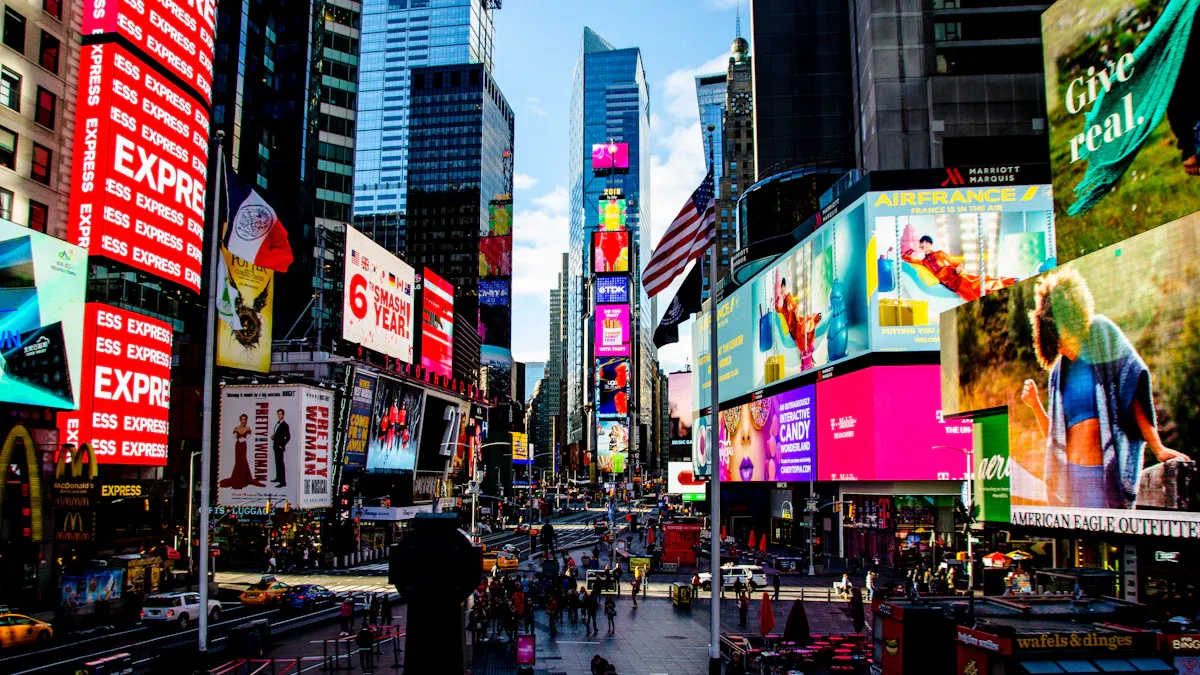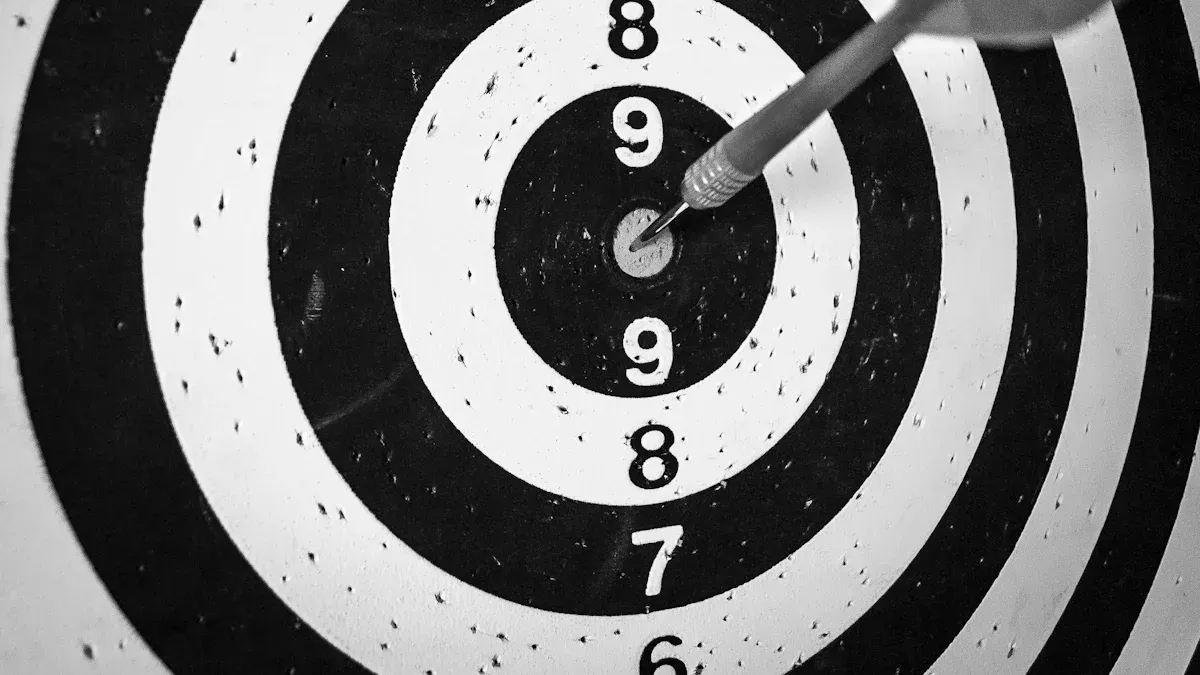
Location-based ad triggers help shoppers make choices and buy things right away. Many big brands get good results by sending special offers at the right time.
Location-Based Marketing Approach | Engagement Impact Metrics | |
|---|---|---|
Starbucks | App promotions based on current location | More people use the app and buy more |
McDonald’s | Offers sent to customers near stores | More people visit stores and join in |
Sephora | Promotions upon store entry | More people come in and take part |
Special offers sent at the best time get more people interested and help more people buy things.
Key Takeaways
Location-based ad triggers give special offers to shoppers. These offers depend on where shoppers are right now. This helps shoppers decide what to buy fast.
Stores use geofencing, beacons, and GPS for this. These tools let stores send ads that fit each shopper. The ads feel important and come at the right time.
Ads that are personal and sent at the right time help shoppers pay more attention. They make people visit stores more. This leads to more sales and loyal customers.
Stores must respect privacy and ask shoppers for clear consent. This builds trust and makes location-based ads work better.
Smart targeting and clear messages help businesses. They stop ads from bothering shoppers. This makes ads more useful and welcome.
Location-based ad triggers

Definition
Location-based ad triggers let businesses send messages or offers to people based on where they are. These triggers use technology to know if someone is near a store, inside a mall, or close to a competitor. Companies use different types of location-based ad triggers to reach shoppers at the best time and place. Some common types are:
Geotargeting: Sends ads to people based on where they live or work. This method uses daily routines to make offers feel more personal.
Geofencing: Makes a virtual line around a place, like a store. When someone walks into this area, they get a push notification or special offer.
Beaconing: Uses small devices with Bluetooth or Wi-Fi to send messages to people inside a store or event. This works well indoors and can help stores sell more.
Mobile targeting: Sends ads through texts or calls, using location and social media data to make the message fit the person.
Note: Location-based ad triggers let stores, restaurants, and hospitals send helpful messages, guide visitors, or give deals. These triggers help businesses talk to customers right away and make their visit better.
How they work
Location-based ad triggers use different technologies to find where a person is. GPS, Wi-Fi, Bluetooth beacons, and RFID help spot a shopper’s location. Businesses set up virtual lines, called geofences, around certain places. When someone with a phone enters this area, the system sends a message or offer.
GPS and Wi-Fi help make geofences for outdoor or big indoor spaces.
Bluetooth beacons work best inside, like in stores, to send messages when someone is very close.
Mobile targeting uses time, device type, and location to choose when to send an ad.
Geo-conquesting targets people near a competitor’s store, trying to bring them to another business.
People must say yes before their location can be tracked. Privacy and consent matter, so companies must tell people how they use this data. For example, a grocery store might send a coupon when a shopper enters the parking lot. A restaurant could send a lunch deal to people walking nearby at noon. These actions help businesses reach the right people at the right time, making ads more helpful and less annoying.
Feature | Bluetooth Beacons | Geofencing |
|---|---|---|
Technology Used | Bluetooth Low Energy (BLE) | GPS, Wi-Fi, or cellular data |
Best Use | Indoor, close-range targeting | Outdoor or large area targeting |
Setup | Place devices in store | Set up virtual boundaries in software |
Example | In-store offers | Notifications near a shopping mall |
Shopper behavior

Personalization
Personalization changes how shoppers react to ads. Location-based ad triggers help businesses send messages that fit where someone is and what they might want. Shoppers notice when an ad feels made for them. This makes them pay more attention and want to act.
Consumer reactance happens when shoppers feel ads are too personal and take away their freedom. Some people ignore or avoid these ads.
Product category involvement is important. Shoppers who do not care much about a product often like in-store personalized ads more. Shoppers who care a lot may feel their choices are being controlled.
Perceived intrusiveness can make shoppers turn away. If an ad uses too much personal data or knows too much about where someone is, it can feel like an invasion.
Contextual factors, like the weather or how busy a place is, change how shoppers react to ads.
The type of promotion matters too. Some shoppers like price deals, while others want non-price offers.
Personalized ads work best when they respect privacy and fit the moment. Marketers use data about where people are and what they do to make ads matter more. For example, a fast-food chain can send a lunch deal to people nearby. A clothing store can offer a jacket discount when it is cold. These ideas help shoppers feel noticed and important.
Immediacy
Immediacy means reaching shoppers at the right time. Location-based ad triggers send offers when shoppers are near or inside a store. This timing makes shoppers act fast.
Smartphones and always-on internet let marketers send real-time, local ads. These ads match what shoppers need right then. For example, a cafe can promote cold drinks on a hot day to people walking by. Event marketers can send discounts to people near a concert. This makes shoppers more likely to visit and buy.
Research shows 72% of shoppers engage more with local content. Geo-targeted searches and timely offers bring more people to stores and boost sales. Almost 90% of marketers say location-based ads lead to more sales and stronger brand loyalty. When shoppers get an offer that fits their needs, they often respond quickly.
Engagement
Engagement grows when ads feel local and relevant. Location-based ad triggers use local details to make ads stand out. For example, ads that mention a nearby landmark or use local words connect better with shoppers.
Studies show ads matched to local context increase engagement. The Dior campaign targeted busy local areas at peak times and got over 2.7 million impressions and a 38% recall rate. Sony used AI to target sports fans with local ads and reached over 11 million people. These campaigns show that local context and timing matter.
Location-based ads do better than regular digital ads. They use geographic data to make ads mean more. Social media campaigns with geo-targeting get higher engagement because the ads fit what shoppers are doing and where they are. Weather-triggered ads and area-specific messages make ads feel like they belong in that place. This helps build stronger connections and leads to more clicks and purchases.
Tip: Marketers can use surveys and feedback tools in stores to learn how shoppers found their offers. This helps improve future campaigns and keeps ads helpful, not annoying.
Conversion impact
Sales data
Location-based ad triggers help stores see real sales results. Many companies use these triggers to send offers when shoppers are close by. This makes more people visit and buy things.
Burger King’s Whopper Detour campaign is a good example. They used geo-conquesting to reach people near other burger places. Because of this, Burger King got 1 million app downloads in a few days and 1.5 million in total. The campaign mixed digital ads with real places, which made more people join in and buy food.
Stores with strong personalization tools make 25% more money. When stores make shopping feel special, customers are 110% more likely to buy extra things. Walmart uses digital tools like “Scan as you Shop” to send ads based on what people buy. Cooler Screens found that digital cooler door ads made people want to buy 12% more and like the brand 7% more. These examples show that location-based ad triggers can help both sales and customer happiness.
Businesses use GPS and geofencing to send deals to people near their stores. These special offers make shoppers want to visit and buy. Geofencing ads get click-through rates from 0.50% to 1%. This is much higher than regular ads, which are below 0.1%. One coffee shop got 24% more visitors in two months by targeting office workers nearby at certain times. Also, 71% of shoppers say they are more likely to buy when they get offers that match their location.
Note: Push notifications reach 90% of users, which is 50% more than email opens. This quick contact helps stores make fast sales.
Location-based marketing uses real-time data to send messages when shoppers are ready to buy. An electronics store used geo-fencing and live inventory to show only items in stock to people nearby. This led to a 32% jump in click-through rates, a 28% rise in store visits, and a 4.1 times better return on ad spend than normal ads. These results show that location-based ad triggers help people buy right away and boost sales.
Stores check the return on investment (ROI) by tracking foot traffic, conversion rates, and cost per visit. They also look at click-through rates and how many people saw the ads in target areas. By comparing these numbers before and after, stores see how much location-based ad triggers help sales.
Repeat visits
Location-based ad triggers do more than just help with one sale. They also help stores build loyalty and get people to come back. When shoppers get offers that fit them, they feel special and want to return.
A Denny’s campaign shows this well. The restaurant sent ads to fast food customers near its stores and near other places. The campaign brought in 25,000 extra visits. A survey showed people who saw the ad were 138% more likely to visit Denny’s again in two weeks. This shows how location-based ads can turn new visitors into regulars.
Many stores link location-based triggers with loyalty programs. For example:
Geofencing and beacons send special offers or loyalty points when customers enter a store.
Mobile wallets like Apple Wallet and Google Wallet show loyalty messages on lock screens, so rewards are easy to see.
Webhook integrations connect location triggers with CRM systems, so stores can follow up and match in-store and online experiences.
Time-based reminders and short-term offers triggered by location keep customers coming back.
Mobile-first loyalty programs use location data to reward people for coming on time or visiting again. These programs can boost engagement by up to 45%. By mixing reminders with loyalty updates, stores keep customers interested without bothering them.
Tip: Personalized, timely, and relevant messages turn casual shoppers into loyal ones. This helps stores keep customers and build long-term relationships.
Best practices
Targeting
Good targeting helps stores reach the right shoppers fast. Marketers use different ways to get better results:
Precise geo-targeting and segmentation help find out who shops and where.
Geofencing makes a virtual line that sends ads when people enter or leave.
Beacon technology lets stores talk to shoppers inside in real time.
Location-based notifications send special offers and reminders to people.
Proximity marketing reaches people close to a store to bring them in.
Social media marketing uses location to show ads to local people.
Search advertising finds users looking for things nearby.
Augmented reality marketing gives fun, interactive experiences in certain places.
Loyalty programs give rewards to people who visit special spots.
Marketers use beacon technology and IP geolocation APIs to find and talk to people right away. They make ads for certain areas, use location words, and build changing campaigns. Mobile ads often use push notifications and work with map or weather apps to reach people at the best time. Personalizing shopping with QR codes, changing web pages, and micro-moments marketing gives shoppers the right content when they need it.
Messaging
Personalized messages make shoppers respond more. Brands send push notifications that match what shoppers like, such as wish lists or things left in carts. This makes more people click and buy. For example, JibJab got 30% more clicks, and Landmark Group saw 56% more buys after using these messages. Location-based push notifications can get up to 45% click rates. People-based geofencing finds real people, not just devices, which helps brands connect better.
Tip: Use urgent, location-based offers to get people to visit stores and decide fast.
Privacy
Respecting privacy helps people trust stores and keeps them following the rules. Companies should:
Be clear about how they collect and use location data.
Make sure users say yes before getting ads.
Explain how data is used and let people say no.
Add privacy policy links in their ads.
Bad privacy can leak private info, hurt a store’s name, and lose money. If data is not handled right, others might use it in the wrong way or find out who people are. Stores must tell users, give choices, and keep up with privacy laws to protect shoppers and themselves.
Challenges
Consent
Businesses have problems when they use location data for ads. One big problem is getting users to agree. Laws like GDPR in Europe say location data is personal. Companies must ask clearly before using this data. People must agree freely, and companies must show proof. In the US, the CCPA lets people say no to sharing or selling their location. Marketers must make it easy for people to say no. They cannot sign people up without asking.
Privacy rules say companies must be honest about data use. They need to tell people what data they collect and why. People should always be able to say yes or no.
Many people worry about privacy and data leaks. These worries make people not want to share their location. Marketers must be honest and keep data safe to build trust. When companies protect privacy, people share their location for rewards or deals. This trust makes ad campaigns work better.
Data can be wrong. Location data comes from many places and can be off because of buildings or weather.
Companies must follow rules and keep data safe from hackers.
Marketers should not send too many ads, or people will get annoyed.
Intrusiveness
Many people think location-based ads are too much. These ads pop up on phones and can stop what people are doing. Sounds, buzzes, or pop-ups can make ads feel worse, especially if they come at a bad time or place. This can make people dislike the ad and the brand. It can also make people less likely to buy.
Studies show ad design can help with this problem. Ads that explain why they show up and match where someone is feel better. For example, geo-fencing ads bother people less than ads that try to take them from other stores. If companies use good data and send ads at the right time, people feel better.
Marketers should not send too many ads to avoid ad fatigue.
They should use good data and respect when and where people want ads.
Clear privacy rules help people feel better about ads.
Tip: Brands can make things better by sending helpful messages only when they matter and by letting people control their ad settings.
Location-based marketing helps people pick what to buy and helps stores sell more. To keep things fair and safe, companies should do a few things.
Ask shoppers if it is okay to use their data and let them say no easily.
Only take the data they really need and keep it safe from others.
Always tell shoppers how their data will be used.
New tools like augmented reality, beacon technology, and 5G will make ads more fun and exact. As these tools get better, stores should use smart rules and learn new ways to keep shoppers’ trust and stay ahead.
FAQ
What is a location-based ad trigger?
A location-based ad trigger sends ads or offers to people based on where they are. Stores use GPS, Wi-Fi, or Bluetooth to know when someone is near and send a message right away.
How do location-based ads help stores?
Location-based ads help stores reach shoppers at the best time. These ads can bring more people into the store and increase sales. Stores can also use them to reward loyal customers.
Are location-based ads safe for privacy?
Most companies ask for permission before using location data. They follow privacy laws and let people choose if they want to share their location. Shoppers can turn off location sharing at any time.
Can shoppers turn off location-based ads?
Yes, shoppers can turn off location-based ads in their phone settings or app preferences. This gives them control over which ads they see and when they get them.
Do location-based ads really work?
Studies show that location-based ads get more clicks and visits than regular ads. Shoppers often respond quickly to offers that match where they are. This helps stores sell more and build customer loyalty.
See Also
Key Developments Influencing Wireless Android Auto Adapters
Best Wireless Android Auto Adapters Reviewed For 2025
Budget-Friendly Portable CarPlay Choices Suitable For All
